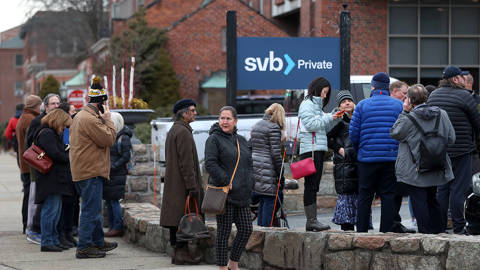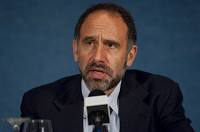When Jerome Powell took over as chair of the Federal Reserve Board in January of 2018, the Fed had already been on a path of gradually hiking interest rates. They had moved away from the Great Recession zero rate in December of 2015 and had been hiking in quarter point increments at every other meeting. The Federal Funds rate stood at 1.25 percent when Powell took over from his predecessor Janet Yellen.
Powell continued with this path of rate hikes until the fall of 2018, and then he did something remarkable: he lowered rates. He had lowered rates by 0.75 percentage points by the time the pandemic hit in 2020.
This reversal was remarkable because it went very much against the conventional wisdom at the Fed and the economics profession as a whole. The unemployment rate at the time was well under 4.0 percent, a level that most economists argued would lead to higher inflation.
However, Powell pointed out that there was no serious evidence of inflationary pressures in the economy at the time. He also noted the enormous benefits of low unemployment. As many of us had long argued, Powell pointed to the fact that the biggest beneficiaries from low unemployment were the people who were most disadvantaged in the labor.
A 1.0 percentage point drop in the unemployment rate generally meant a drop of 1.5 percentage points for Hispanic workers and 2.0 percent for Black workers. The decline was even larger for Black teens. Workers with less education saw the biggest increase in their job prospects. And, in a tight labor market, employers seek out workers with disabilities and even those with criminal records.
In short, there are huge benefits to pushing the unemployment rate as low as possible, and Powell happily pointed to these benefits as he lowered interest rates even in an environment where the economy was already operating at full employment by standard estimates. Powell was willing to put aside the Fed’s obsession with fighting inflation, even when it wasn’t there.
This was the reason that many progressives, including me, wanted President Biden to reappoint Powell. While Lael Brainard, who was then a Fed governor, would have also been an outstanding pick, as a Republican, Powell’s reappointment faced far fewer political obstacles. There was no risk that one of our “centrist” showboat senators (Manchin and Sinema) might seize on some real or imagined slight and block the nomination.
Powell was also likely to have more leeway as a second term chair in pursuing a dovish interest rate policy. Fed chair is a position where seniority matters a lot, as can be seen by the Greenspan worship that stemmed largely from his long service as Fed chair. Although Brainard was a highly respected economist, she might have a harder time staying the course if the business press pushed for higher rates.
Powell’s Pandemic Policy
Powell did pursue a dovish policy, acting aggressively to support the economy during the pandemic with both a zero federal funds rate, and also extensive quantitative easing that pushed the 10-year Treasury bond rate to under 1.0 percent in the summer of 2020. Low rates helped to spur construction and allowed tens of millions of people to refinance mortgages, saving thousands of dollars a year on interest rates.
As virtually everyone (including me) would now agree, he kept these expansionary policies in place for too long. While Fed policy was not the major factor in the pandemic inflation, it did play a role, especially in the housing market. While most of the rise in house prices and rents was driven by fundamentals in the market (unlike in the bubble years from 2002-2007), there was clearly a speculative element towards the end of 2021 and the start of 2022.
This became evident when the Fed first raised rates in March of 2022. Even though the initial hike was just 0.25 percentage points, the housing market changed almost immediately. Prior to the hike, almost every house immediately got multiple above listing offers. After the hike, many houses received no offers and it became standard for buyers to offer prices well below the asking price.
Given this outcome, it would have been good if the Fed had made this move several months sooner. Speculative runups in house prices are not good news for the economy in general, even if there may be a small number of lucky sellers who might hit the peak of the market.
Anyhow, after having waited too long to raise rates, Powell felt the need to re-establish his status as a determined inflation fighter. He embarked on a series of aggressive three-quarter point rate hikes and repeatedly appealed to the ghost of Paul Volcker.
Powell went farther and faster than many of us felt was warranted. It will take time to see the full effect of past rate hikes on the economy. The rapid rise in rates did create stresses in the banking system, although the failures of the Silicon Valley Bank (SVB) and Signature Bank seem to be largely due to incredibly inept management, coupled with major regulatory failures at the Fed.
While bank failures are always fun, the more important issue is what happens to the real economy. At this point it seems the economy faces greater risk on the downside, with unemployment rising, than with inflation reversing its current downward path.
There has been a clear hit to credit availability as a result of banks tightening standards following the SVB panic. Higher rates are also having their expected effect on loan availability. Housing starts have slowed sharply, although residential construction remains strong due to a large backlog of unfinished homes resulting from supply chain problems during the pandemic.
Higher rates have also put an end to the flood of housing refinancing that helped to support consumption growth through the pandemic. And, non-residential investment has also slowed sharply in recent months.
For these reasons, there are real grounds for expecting a growth slowdown and a resulting rise in the unemployment rate. The other side of the story is that it looks as the Fed has won its war on inflation.
I’ll admit to having been an inflation dove all along, but the facts speak for themselves. We know that housing inflation will slow sharply in the months ahead based on private indexes of marketed housing units. These indexes have been showing much lower inflation, and even deflation, since the late summer. They lead the CPI rental indexes by 6-12 months.
We got the first clear evidence of lower inflation in the CPI rental indexes with the March release, with both rent indexes rising just 0.5 percent, after rising at more than a 9.0 percent annual rate in the prior three months. The CPI rent indexes are virtually certain to show further declines over the course of the year, with rental inflation likely falling below its pre-pandemic pace.
Much has been made of the big bad news items in the March CPI, the 0.4 percent rise in new vehicle prices. This is certainly bad news for the immediate inflation picture as it seems that supply chain problems continue to limit the production of new cars and trucks.
But this is not a long-term inflation issue. We have not forgotten how to build cars and trucks. This is a story where the chip shortage, resulting from a fire at a major semi-conductor factory in Japan, has proved to be more enduring that many had expected. That hardly seems like a good reason to be raising interest rates and throwing people out of work.
The picture for many non-housing services was also positive. In particular, the medical services index fell 0.5 percent in March after dropping 0.7 percent in each of the prior two months. Some of this decline is due to the peculiarities of the way health insurance costs are measured in the CPI, but it is pretty hard to tell a story of excessive inflation in this key sector of the economy.
The March Producer Price Indexshowed even better news about inflationary pressures at earlier stages of production. The overall final demand index fell by 0.5 percent in March, while the index for final demand for services dropped by 0.3 percent. While there are areas where there seem to be price pressures, the overwhelming picture in this release is one of sharply lower inflation, or even deflation. Clearly higher inflation will not be driven by price pressures at the wholesale level.
Perhaps most importantly, the pace of wage growth has slowed sharply. The annualized rate of growth in the average hourly wage over the last three months is just 3.2 percent, down from a 6.0 percent pace at the start of 2022. This is lower than the pace of wage growth in 2018 and 2019, when inflation was below the Fed’s 2.0 percent target. It is very difficult to tell a story where wage growth is under 4.0 percent, and inflation is still much above the Fed’s target.
Can Powell Change Course Again?
This raises the question as to whether Powell will again follow the path he took in 2019 and reverse course when the data indicate it is appropriate? There is still much uncertainty about the course of the economy at this point. We don’t know the full effect of the fallout from the SVB failure and it’s not clear how much of the impact of past Fed rate hikes is yet to be felt.
That makes a strong argument for a pause at the Fed’s meeting next month, which will come before we get any data from April. However, if we continue to see evidence of economic weakness, as well as slowing inflation, the Fed needs to be prepared to start lowering rates.
Powell was quite vocal in recognizing the Fed’s twin mandate for full employment, as well as price stability, when he lowered rates in 2019. There is no virtue in going overboard in the effort to fight inflation. If the data show that the war on inflation has been won, and we see the prospect of a weakening economy with higher unemployment, it needs to shift course.
Powell went in the right direction four years ago when he bucked the conventional wisdom and lowered rates in 2019. He needs to be prepared to do that again this year.






